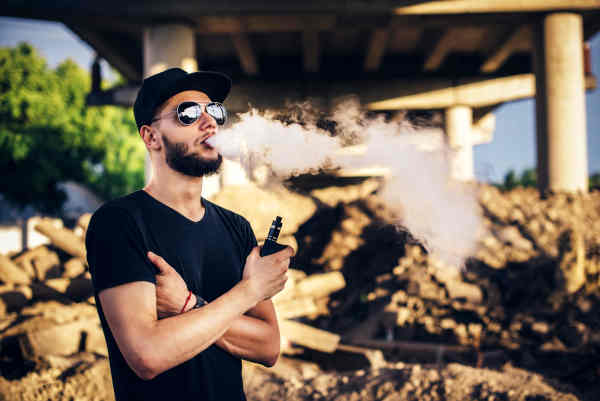Turning 21
- Regulation
- June 25, 2019
- 12 minutes read

Photo: Oleksandr Bedenyuk | Dreamstime.com
As retailers and government entities in the U.S. raise the age to purchase vapor products to 21, some doubt the measure’s effectiveness.
By Timothy S. Donahue
Hawaii was the first. Now, 14 additional U.S. states, including Arkansas, California, Delaware, Illinois, Maine, Maryland, Massachusetts, New Jersey, Oregon, Texas, Utah, Vermont, Virginia and Washington, have raised the minimum age to purchase vapor and tobacco products from 18 to 21.
At least 470 localities, including New York City; Chicago; San Antonio; Boston; Cleveland; Minneapolis; Kansas City, Kansas; and Kansas City, Missouri, as well as Washington, D.C., have raised the minimum tobacco and vapor product purchase age to 21, according to the Campaign for Tobacco-Free Kids. Some of the vicinities are in states that subsequently enacted statewide ordinances. Soon, the U.S. government may also raise the legal age to purchase tobacco from 18 to 21 nationwide.
The biggest surprise came in early May, when Walmart, the world’s largest retailer, announced that beginning July 1, it would raise the minimum age to purchase tobacco products, including electronic nicotine-delivery systems (ENDS), to 21 at its 5,000 Walmart and Sam’s Club stores. The company stated that it is also phasing out the sale of fruit-flavored and dessert-flavored ENDS products and e-liquids.
The announcement came in response to a letter from then-U.S. Food and Drug Administration (FDA) Commissioner Scott Gottlieb that threatened to fine a dozen retailers, including Walmart, Walgreens, Kroger, Rite Aid and Family Dollar, for illegally selling tobacco products to youth under the age of 18.
In its letter to Walmart, the regulatory agency stated that it found 17 percent of Walmart stores had sold vapor and tobacco products to minors since 2010 (by comparison, 7-Eleven had a violation rate of 25 percent, compared with 41 percent at Marathon Petroleum, according to the FDA).
“This violative history is disturbing and cannot possibly come as a surprise to corporate leadership. In addition to issuing a warning letter, civil money penalty or no-tobacco sale order, as applicable, to violating retailers, [the] FDA also makes retailer compliance check results publicly available in a searchable database that can be accessed by any member of the public, including by the corporate management of retailers themselves,” the FDA letter states. “These illegal sales must stop.”
Walmart does not agree with the FDA’s calculations. “Since 2010, the FDA has conducted approximately 12,800 retailer compliance checks involving minors at Walmart stores and Sam’s Club locations. Over that period, Walmart and Sam’s Club passed 93 percent and 99 percent, respectively, of those checks,” wrote Walmart’s senior vice president and U.S. chief ethics and compliance officer, John Scudder, in response to the FDA’s accusations.
“Most recently, in 2018, Walmart stores passed 94 percent of the more than 2,400 FDA checks, and Sam’s Club passed 100 percent of its 15 FDA checks. While we are not satisfied with falling short of our company-wide goal of 100 percent compliance, those compliance rates nonetheless are significantly higher than the rates referenced in Dr. Gottlieb’s April 5 letter—and, in our view, more fairly and accurately portray our performance.”
Other retailers have also raised the minimum purchase age to 21 in their stores, including Walgreens and Rite Aid. The FDA called Walgreens one of the top violators among pharmacies that sell tobacco, with 22 percent of locations failing FDA inspections. Rite Aid announced it would remove e-cigarettes and vapor products chain-wide. The tobacco company Altria and e-cigarette manufacturer Juul Labs are also supporting an age increase in vapor product purchases.
On the federal level, as of May 21, there were two bills in the U.S. Senate aimed at raising the purchase age to 21 for vapor and tobacco products. Senator Todd Young of Indiana is among four authors who were the first to introduce legislation centered on raising the age to purchase tobacco products in this legislative session. Young claims it’s the most attainable and noteworthy thing Congress can do to lower healthcare costs and save lives. He says that, according to the U.S. Centers for Disease Control and Prevention (CDC), smoking-related illnesses cost the U.S. $300 billion a year. Senators Mitt Romney, Brian Schatz and Dick Durbin, along with Young, authored the Tobacco to 21 Act.
On May 20, Senate Majority Leader Mitch McConnell said he supports raising the age and introduced his own bill, which was co-authored by Senator Tim Kaine. Young says his proposal is a clean bill with no exemptions, and he says McConnell should have just signed on to that version. Young says he has “hopes and confidence” his bill will become law.
McConnell says his bill will also save lives. “In recognition of tobacco’s history in our states and aware of the threat that all tobacco products pose now and for future generations, we introduced legislation to raise the national age of purchase to 21,” he stated in a press release. “We’ve heard from countless parents who have seen the youth vaping crisis firsthand, and together Senator Kaine and I are addressing this public health crisis head-on. By making it more difficult for tobacco products to end up in the hands of middle school and high school students, we can protect our children and give them the opportunity to grow and develop into healthy adults.”
THE OTHER SIDE
Despite this trend, some vape shop owners are unsure whether they should raise the minimum purchase age in their shops to 21. Several of the vape shops contacted asked not to be included in this story because the issue is so devisive. However, numerous owners said off the record that they don’t see raising the age as the answer to the problem of youth use, pointing to the experience of the alcohol industry.
Sam Salaymeh, president and CEO of North America for AMV Holdings, which owns Madvapes, Alohma, Maxx and Select-A-Vapor stores, supports eliminating youth access but says that raising the purchase age may be less effective than some believe. “It hasn’t made a difference with alcohol,” he says. “We have a serious problem with teen binge drinking in the U.S.”
Alcohol is the most commonly used and abused drug among youth in the United States, according to the CDC. Its website states that while drinking by persons under the age of 21 is illegal, people aged 12 to 20 years drink 11 percent of all alcohol consumed in the U.S., and more than 90 percent of this alcohol is consumed during sessions of binge drinking.
In 2016, the National Survey on Drug Use and Health reported that 19 percent of those between the ages of 12 and 20 drink alcohol, and 12 percent reported binge drinking in the past 30 days. In 2017, the “Monitoring the Future” survey reported that 8 percent of eighth graders and 33 percent of 12th graders had consumed alcohol during the past 30 days, and 2 percent of eighth graders and 19 percent of 12th graders had binge drank during the past 30 days. The 10–19 age group makes up 13 percent of the U.S. population, according to 2017 census data.
Until a law raising the minimum age for purchasing tobacco from 18 to 21 is passed federally, there are a plethora of issues with raising the purchase age in just one specific state or city. For example, Kansas City, Kansas, raised the age to 21 while neighboring communities retained the age minimum of 18. This is an issue with neighboring states as well.
If an 18-year-old in North Carolina buys legal vapor products and they then travel to Virginia, they are breaking the law in Virginia by being in possession of a product that was legal where it was purchased. Also, store owners cannot prevent someone of legal age from purchasing a product and giving it to a minor.
Research has shown that youth often have their older friends and classmates purchase vapor and other tobacco products for them. According to numerous studies, increasing the purchase age for vapor and other tobacco products to 21 would reduce the probability of a high school student being able to legally purchase these products for other students and/or their underage friends.
Retailers are also concerned that a higher minimum age may push people toward unsavory sources. “What is even worse is that what is happening in the vapor industry is increasing the size of the black market too,” Salaymeh says. “Teens will go to the black market to get the products they want.”
There are simpler arguments as well. One example is that there just isn’t any justification for raising the age to buy vapor and other tobacco products, according to Ramesh Ponnuru, a researcher with the American Enterprise Institute, a public policy think tank.
The main argument for the U.S. senators pushing their Tobacco 21 agenda “is that most tobacco users take up their habit before age 21 and that making them wait will improve their health,” says Ponnuru. “The senators write that ‘if the current rates of smoking continue, the CDC projects 5.6 million of today’s youth will eventually die from preventable smoking-related illnesses.’”
That projection is based on combustible cigarettes not e-cigarettes; legal restrictions cannot be justified on the latter, says Ponnuru. “But in either case, the question remains: Why not let adults decide for themselves what risks to take? And if we’re not going to let 20-year-olds take the health risk of smoking, why should we let people one year older?” he asks.
Some states have exemptions for military personnel in their Tobacco 21 laws. That’s also one of the main differences between the two bills in the U.S. Senate. Salaymeh says that raising the age for military personnel doesn’t make sense. “If you are old enough to join the military, you should be old enough to make the decision to use nicotine,” he says. “It’s not that I don’t agree with the military exemption; it’s that the exemption should be for everyone over the age of 18, including the military.”
McConnell stated that a military exemption in Young’s bill was one of the deciding factors in drafting his own legislation. “On further reflection, I decided the military carve-out made no sense,” McConnell said.
Not all U.S. states support raising the age to 21 either. Nebraska, for example, will require its residents to be 19 years old in order to vape nicotine legally after a bill, introduced by Senator Dan Quick of Grand Island, Nebraska, was passed unanimously on May 24. The restrictions take effect Jan. 1. The higher age limit doesn’t apply to vapor products that do not contain any nicotine.
Salaymeh says he believes that we need to have proper regulation that limits youth access in ways that work. “As a company, we have spent a large amount of funds to develop software to prevent underage sales. A customer must have a legal, valid ID scanned in order to make a purchase in all our stores, and we comply with all local and state laws for purchase age. We have extensive employee training procedures. We have a zero tolerance policy,” he says. “We also limit the number of pods a single person can purchase. These are effective measures in preventing youth access.”
